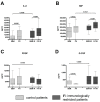A Pronounced Inflammatory Activity Characterizes the Early Fracture Healing Phase in Immunologically Restricted Patients
- PMID: 28282868
- PMCID: PMC5372599
- DOI: 10.3390/ijms18030583
A Pronounced Inflammatory Activity Characterizes the Early Fracture Healing Phase in Immunologically Restricted Patients
Abstract
Immunologically restricted patients such as those with autoimmune diseases or malignancies often suffer from delayed or insufficient fracture healing. In human fracture hematomas and the surrounding bone marrow obtained from immunologically restricted patients, we analyzed the initial inflammatory phase on cellular and humoral level via flow cytometry and multiplex suspension array. Compared with controls, we demonstrated higher numbers of immune cells like monocytes/macrophages, natural killer T (NKT) cells, and activated T helper cells within the fracture hematomas and/or the surrounding bone marrow. Also, several pro-inflammatory cytokines such as Interleukin (IL)-6 and Tumor necrosis factor α (TNFα), chemokines (e.g., Eotaxin and RANTES), pro-angiogenic factors (e.g., IL-8 and Macrophage migration inhibitory factor: MIF), and regulatory cytokines (e.g., IL-10) were found at higher levels within the fracture hematomas and/or the surrounding bone marrow of immunologically restricted patients when compared to controls. We conclude here that the inflammatory activity on cellular and humoral levels at fracture sites of immunologically restricted patients considerably exceeds that of control patients. The initial inflammatory phase profoundly differs between these patient groups and is probably one of the reasons for prolonged or insufficient fracture healing often occurring within immunologically restricted patients.
Keywords: bone healing; chemokines; cytokines; fracture healing; fracture hematoma; immune cells; immunologically restricted patients; inflammation.
Conflict of interest statement
The authors declare no conflict of interest.
Figures






References
-
- Ishikawa M., Nishioka M., Hanaki N., Miyauchi T., Kashiwagi Y., Kawasaki Y., Miki H., Kagawa H., Ioki H., Nakamura Y. Postoperative host responses in elderly patients after gastrointestinal surgery. Hepatogastroenterology. 2006;53:730–735. - PubMed
MeSH terms
Substances
LinkOut - more resources
Full Text Sources
Other Literature Sources
Miscellaneous

